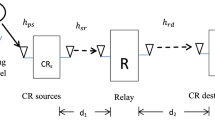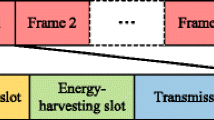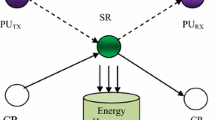Abstract
This paper studies the achievable total throughput of an energy harvesting cooperative cognitive radio (CR) network. A CR transmitter cooperates with a primary user (PU) transmission if PU is found to be present in the given channel while it transmits its own data in the absence of PU. The CR transmitter is an energy harvesting node which harvests simultaneously from non-RF signal as well as RF signal of PU. The CR transmitter uses the harvested energy on shared basis for cooperation and transmission. The same study is also extended for cooperation of multiple CRs in multiple PU band scenario. In cooperation in muti-band scenario, all CRs sense all PU channels and sensing informations are fused at fusion centre to know about the status of PU. Performance is investigated in terms of total network throughput for several parameters such as sensing time, energy splitting parameter, and energy allocation ratio etc. Novel analytical expressions for total useful throughput and optimal energy allocation ratio parameter under the considered network scenario are developed. Useful throughput and optimal energy allocation ratio parameter are also estimated for a target secondary network (CR network) throughput under a quality of service constraint of PU such as collision probability. It is observed that the value of optimal energy allocation parameter gets reduced if the number of CRs in cooperation increases or the number of PU channels increases.









Similar content being viewed by others
References
Amjad, M., Rehmani, M. H., & Shiwen, M. (2018). Wireless multimedia cognitive radio networks: A comprehensive survey. IEEE Communications Surveys and Tutorials, 20(2), 1056–1103.
Nitti, M., Murroni, M., Fadda, M., & Atzori, L. (2016). Exploiting social internet of things features in cognitive radio. IEEE Access, 4, 9204–9212.
Liang, Y. C., Zeng, Y., Peh, E. C. Y., & Tuan Hong, A. (2008). Sensing-throughput tradeoff for cognitive radio networks. transactions on Wireless Communications, 7(4), 1326–1337.
Wu, Y., & May, T. D. H. K. (2011). Energy efficient spectrum sensing and transmission for cognitive radio system. IEEE Communications Letters, 15(5), 545–547.
Jaein, K., Lee, H., Song, C., Taeseok, O., & Lee, I. (2017). Sum throughput maximization for multi-user MIMO cognitive wireless powered communication networks. IEEE Transactions on Wireless Communications, 6(2), 913–923.
Cai, L., Poor, H., Liu, Y., Luan, T., Shen, X., & Oct, M. J. (2011). Dimensioning network deployment and resource management in green mesh networks. IEEE Communications Letters, 18(5), 58–65.
Mao, S., Cheung, M. H., & Wong, V. (2012). An opimal energy allocation algorithm for energy harvesting wireless sensor networks. In Proceedings of IEEE international conference on communications (ICC12) (pp. 265–270).
Chatterjee, S., Maity, S. P., & Acharya, T. (2015). On opimal sensing time and power allocation for energy efficient cooperative cognitive radio networks. In Proceedings of IEEE ANTS 2015 (pp. 1–6).
Park, S., & Hong, D. (2014). Achievable throughput of energy harvesting cognitive radio networks. IEEE Transactions on Wireless Communications, 13(2), 1010–1022.
Bhowmick, A., Roy, S. D., & Kundu, S. (2015). Performance of secondary User with combined RF and non-RF based energy-harvesting in cognitive radio network. In Proceedings of IEEE ANTS (pp. 1–3).
Liu, X., Li, F., & Na, Z. (2017). Optimal resource allocation in simultaneous cooperative spectrum sensing and energy harvesting for multichannel cognitive radio. IEEE Access, 5, 3801–3812.
Yang, J., Ulukus, S. (2012). Optimal packet scheduling in an energy harvesting communication system. IEEE Transactions on Communications, 60(1), 220–230.
Tutuncuoglu, K., & Yener, A. (2012). Optimum transmission policies for battery limited energy harvesting nodes. IEEE Transactions on Wireless Communications,11(3), 1180–1189.
Shafie, A. E., Ashour, M., Khattab, T., & Mohamed, A. (2015). On spectrum sharing between energy harvesting cognitive radio users and primary users. In Proceedings of international conference on computing, networking and communications (ICNC), IEEE, Garden Grove, CA (pp. 214–220).
Zhai, C., Liu, J., & Zheng, L. (2016). Relay-based spectrum sharing with secondary users powered by wireless energy harvesting. IEEE Transactions on Communications, 64(5), 1875–1887.
Kalamkar, S. S., Jeyaraj, J. P., Banerjee, A., & Rajawat, K. (2016). Resource allocation and fairness in wireless powered cooperative cognitive radio networks. IEEE Transactions on Communications, 64(8), 3246–3261.
Liu, X., Li, F., & Na, Z. (2016). Optimal resource allocation in simultaneous cooperative spectrum sensing and energy harvesting for multichannel cognitive radio. IEEE Access, 5, 3801–3812.
Hong, X., Kang, X., Wong, K.-K., & Nallanathan, A. (2017). Optimizing DF cognitive radio networks with full-duplex-enabled energy access points. IEEE Transactions on Wireless Communications, 16(7), 4683–4697.
Yao, Y., Yin, C., Song, X., & Beaulieu, N. C. (2016). Increasing throughput in energy-based opportunistic spectrum access energy harvesting cognitive radio networks. Journal of Communications and Networks, 18(3), 340–350.
Chi, X., Zheng, M., Liang, W., Haibin, Y., & Liang, Y.-C. (2017). End-to-end throughput maximization for underlay multi-hop cognitive radio networks with RF energy harvesting. IEEE Transactions on Wireless Communications, 16(6), 3561–3572.
El Shafie, A., & Sultan, A. (2013). Optimal random access for a cognitive radio terminal with energy harvesting capability. Journal of Communications and Networks, 17(6), 1128–1131.
Michele, S., & Maurizio, M. (2010). Nonconvex optimization of collaborative multiband spectrum sensing for cognitive radios with genetic algorithms. International Journal of Digital Multimedia Broadcasting, 2010, 1–12.
Furtado, A., Irio, L., Oliveira, R., Bernardo, L., & Dinis, R. (2016). Spectrum sensing performance in cognitive radio networks with multiple primary users. IEEE Transactions on Vehicular Technology, 65(3), 1564–1574.
Si, J., Li, Z., Yang, D., & Yan, Z. (2015). Parallel cooperative sensing in multichannel cognitive radio networks with partial CSI. International conference on wireless communications & signal processing (WCSP). (pp. 1–6).
Boulogeorgos, A. A., Chatzidiamantis, N. D., & Karagiannidis, G. K. (2016). Spectrum sensing with multiple primary users over fading channels. IEEE Communications Letter, 20(7), 1457–1460.
Ejaz, W., & Ibnkahla, M. (2018). Multiband Spectrum sensing and resource allocation for IoT in cognitive 5G networks. IEEE Internet of Things Journal, 5(1), 150–163.
Zhang, R., & Ho, C. K. (2013). MIMO broadcasting for simultaneous wireless information and power transfer. IEEE Transactions on Wireless Communications, 12(5), 1989–2001.
Nasir, A. A., Zhou, S. D., Durrani, S., & Kennedy, R. A. (2014). Throughput and ergodic capacity of wireless energy harvesting based DF relaying network. In Proceedings of IEEE international conference on communications (ICC14) (pp. 4066–4071).
Zhiping, S., Kah, C. T., & Kwok, H. L. (2013). Energy efficient joint design of sensing and transmission durations for protection of primary user in cognitive radio systems. IEEE Communications Letters, 17(3), 565–568.
Liu, Y., & Tewfik, A. (2014). Primary traffic characterization and secondary transmissions. IEEE Transactions on Wireless Communications, 13(6), 3003–3016.
Bhowmick, A., Sanjay, D. R., & Kundu, S. (2016). Throughput of a cognitive radio network with energy-harvesting based on primary user signal. IEEE Wireless Communications Letter, 5(2), 136–139.
Author information
Authors and Affiliations
Corresponding author
Rights and permissions
About this article
Cite this article
Bhowmick, A., Das, G.C., Roy, S.D. et al. Allocation of optimal energy in an energy-harvesting cooperative multi-band cognitive radio network. Wireless Netw 26, 1033–1043 (2020). https://doi.org/10.1007/s11276-018-1849-2
Published:
Issue Date:
DOI: https://doi.org/10.1007/s11276-018-1849-2




